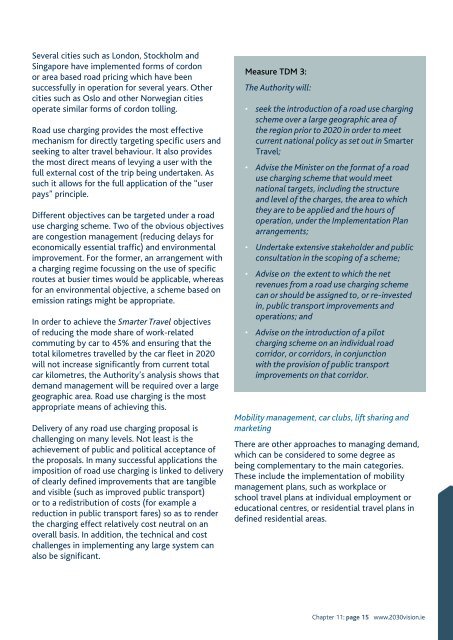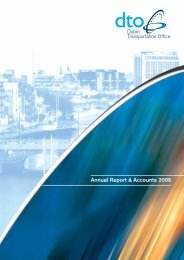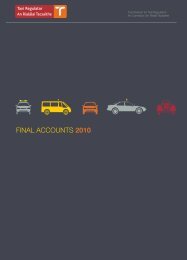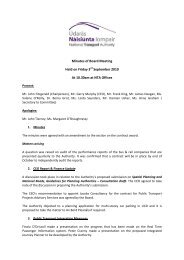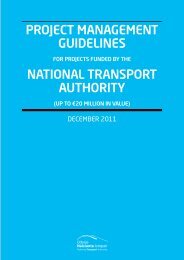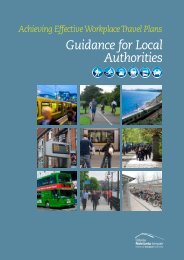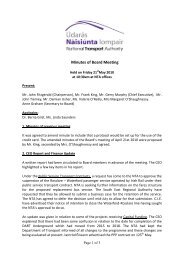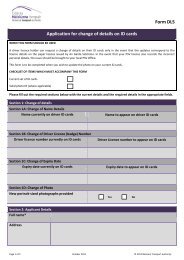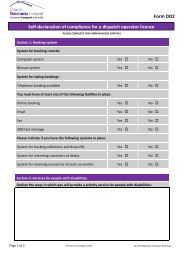Greater Dublin Area Draft Transport Strategy 2011-2030
Greater Dublin Area Draft Transport Strategy 2011-2030
Greater Dublin Area Draft Transport Strategy 2011-2030
- No tags were found...
You also want an ePaper? Increase the reach of your titles
YUMPU automatically turns print PDFs into web optimized ePapers that Google loves.
Several cities such as London, Stockholm andSingapore have implemented forms of cordonor area based road pricing which have beensuccessfully in operation for several years. Othercities such as Oslo and other Norwegian citiesoperate similar forms of cordon tolling.Road use charging provides the most effectivemechanism for directly targeting specific users andseeking to alter travel behaviour. It also providesthe most direct means of levying a user with thefull external cost of the trip being undertaken. Assuch it allows for the full application of the “userpays” principle.Different objectives can be targeted under a roaduse charging scheme. Two of the obvious objectivesare congestion management (reducing delays foreconomically essential traffic) and environmentalimprovement. For the former, an arrangement witha charging regime focussing on the use of specificroutes at busier times would be applicable, whereasfor an environmental objective, a scheme based onemission ratings might be appropriate.In order to achieve the Smarter Travel objectivesof reducing the mode share of work-relatedcommuting by car to 45% and ensuring that thetotal kilometres travelled by the car fleet in 2020will not increase significantly from current totalcar kilometres, the Authority’s analysis shows thatdemand management will be required over a largegeographic area. Road use charging is the mostappropriate means of achieving this.Delivery of any road use charging proposal ischallenging on many levels. Not least is theachievement of public and political acceptance ofthe proposals. In many successful applications theimposition of road use charging is linked to deliveryof clearly defined improvements that are tangibleand visible (such as improved public transport)or to a redistribution of costs (for example areduction in public transport fares) so as to renderthe charging effect relatively cost neutral on anoverall basis. In addition, the technical and costchallenges in implementing any large system canalso be significant.Measure TDM 3:The Authority will:• seek the introduction of a road use chargingscheme over a large geographic area ofthe region prior to 2020 in order to meetcurrent national policy as set out in SmarterTravel;• Advise the Minister on the format of a roaduse charging scheme that would meetnational targets, including the structureand level of the charges, the area to whichthey are to be applied and the hours ofoperation, under the Implementation Planarrangements;• Undertake extensive stakeholder and publicconsultation in the scoping of a scheme;• Advise on the extent to which the netrevenues from a road use charging schemecan or should be assigned to, or re-investedin, public transport improvements andoperations; and• Advise on the introduction of a pilotcharging scheme on an individual roadcorridor, or corridors, in conjunctionwith the provision of public transportimprovements on that corridor.Mobility management, car clubs, lift sharing andmarketingThere are other approaches to managing demand,which can be considered to some degree asbeing complementary to the main categories.These include the implementation of mobilitymanagement plans, such as workplace orschool travel plans at individual employment oreducational centres, or residential travel plans indefined residential areas.Chapter 11: page 15 www.<strong>2030</strong>vision.ie


